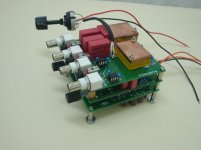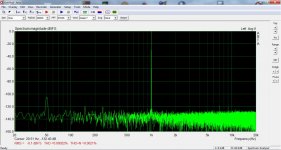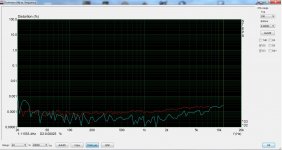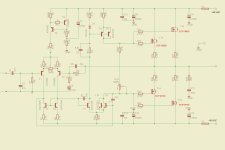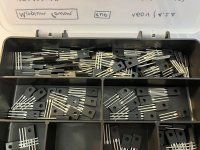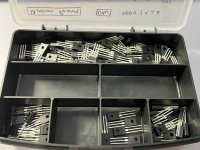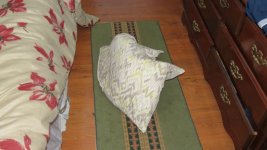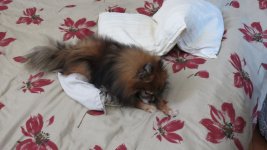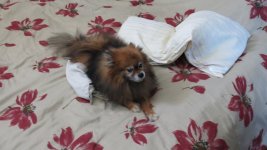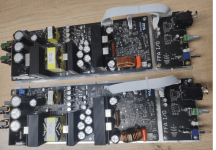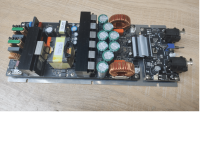The Keystone Sub™ cabinet works well with a variety of speakers of quite different parameters and sizes.
The Keystone is named for it’s exit shape, similar to a keystone. Like keystone lens correction for off axis projection, the keystone exit corrects some frequency response problems that result when a rectangular exit is used with the particular fold pattern employed in it’s construction.
Any person wishing to duplicate my Welter Systems designs for their own use is welcome to,
any person or corporate entity that would like to produce them for sale please contact me to arrange a licensing deal to avoid violation of intellectual property rights as defined in section 27 of the Universal Declaration of Human Rights adopted as international law in 1976.
Similar in size to many 2x18” cabinets, exterior
dimensions are 45 inches tall, 26.5 wide, 22.5 deep.
Weight is around 150 pounds, 68 Kilos, depending on the drivers and plywood used.
More information about the design are available in these posts:
Tapped Horn Vs. Bass Reflex Case Study - diyAudio
Horn Extender/Wave-guide for TH
Tapped Horn Directivity
Corrected plans are available in post #
487, including parts layout, thanks to NEO Dan, with the exception that the bottom of part "F" is 89 degrees, the front of "G" is a 5 degree angle, the back of "G" is 3 degrees as shown in post #478.
The previous plans #94 and #97 (thanks Oliver) have some errors due to my providing Oliver with some incorrect numbers, sorry for the confusion.
Assembly instructions are in post #1525:
https://www.diyaudio.com/community/...ng-18-15-12-inch-speakers.185588/post-7043072
Photos of finished Keystone Subs and the bass reflex (BR) cabinet as it was used for testing are in post 1039.
Photos of the cabinet interior are in Post #99 and clarification of the 9 braces used in #206 and #451.
Distortion results are in post #12, there is a typo: The * should read: third (odd order) harmonic louder than second.
Those tests were done using 77 volt sine waves
(kids, don't try this at home!!), a bit less than "full power", used the 1500W AES power specification of another B&C driver rather than the 1700 W rating of the 18SW115-4.
The upper reduction in output noted in the TH sine wave tests compared to the BR tests are due to the TH upper pass band low impedance points, while the BR has a steadily rising impedance. As the tests were started from low frequency, which has better heat pumping, and ended with upper frequencies, which don't pump as much heat from the voice coil, the upper pass band compression noted in the TH compared to the BR was due to the lower upper impedance causing voice coil heating, raising impedance, causing "power compression" at 77 volts, after less than 50% duty cycle over a few minutes time.
Hornresp inputs are available in post #96 and 130.
The link explaining how distortion was measured expired, an explanation is in post #315, and a correction in #316.
PASC built a Keystone Sub TH ("tapped horn") and a xoc1 18" TH and reported his findings in posts #114 & 115.
The lower frequency response corners using a partially covered exit, ("step down" mode) is in #262, but the description is wrong:"TH18S20" has the upper 5 inches of the exit covered with plywood, exit is 20" from bottom to top. The "step down" cover results in as much as an 8 dB increase in 30 Hz level (with only 8" from bottom to top left open), but with progressive losses in the upper bass range, so for most music the trade off is not worth the extension.
The
Keystone B-Low (a low "B" note is 30.87 Hz) testing started early October of 2017, initial reports using a B&C18TBW100-4 driver are in post #1135. Photos and the response curves with the B&C18TBW100-4 and the 15” Dayton PA385S-8 and a "step down" cover plate are in post #1167.
Comparative tests using the Keystone Sub loaded with an 18 inch B&C18SW115 (four ohm nominal), a 15 inch Eminence 4015LF (eight ohm), and two Eminence Lab 12 (6/2 =3 ohm) were conducted in March of 2011.
The same 16.6 inch diameter cut out was used in each case, the 4015LF used a “doughnut” adapter, the Lab 12s used an adapter that centered the two speakers on the cut out and provided a stand off so they would not slap at high excursions. The Lab 12s have a "saddle shape" frequency contour, the 96 Hz peak needs to be removed with EQ for flat response.
There are a few other peaks and dips in the response curves due to very windy conditions, often requiring waiting minutes between gusts to record responses. Test day was literally a sand storm, the bottom of the cabinet was filled with coal dust and tumbleweeds after.
All the speakers were driven with the same level. The 4015LF is actually about the same sensitivity as the 2x12 pair, since it has about double the impedance minima.
A BR (bass reflex) LAB 2x12" (36 FB) cabinet, exactly half the size of the Keystone sub is shown in the blue trace, it’s upper response is slightly reduced due to a Butterworth 125 Hz filter, all the other subs used a BW 1000 Hz filter.
As can be seen the 15.5 gross cubic foot Keystone Sub TH loaded with the B&C18SW115-4 sensitivity averages 6 dB greater than a 8.75 gross cubic foot BR.
Twice the power and drivers in a pair of BR cabinets weighing at least 40 pounds more, and occupying 2 cubic feet more trailer space are required to equal the SPL output of one Keystone Sub. The pair of BR would be capable of few dB more output below 45 Hz, the Keystone Sub +3dB or more SPL above 45Hz, more "punch" where you may want it.
There are subjective sonic differences between the TH Keystone Sub and the BR cabinet when they are driven hard enough to approach the thermal and linear excursion limits of the driver. Running subs at "full tilt boogie" is common for most applications desiring the maximum output for the minimum trailer space, and the most "bang for the buck".
1) The TH cone is under more stress at the same input voltage than the BR, this results in slightly more distortion, and the distortion spectra is at different harmonic points- the TH sounds "louder" when driven hard.
2) The BR looses LF output due to "port compression" (turbulence) relative to upper level. The TH does not suffer from any "port compression", but suffers from more upper pass-band "power compression" than the BR. The net result is the TH sounds a bit more "aggressive" (more 45-100 Hz output) at low drive levels compared to the BR, but at high drive levels, sounds "fatter" due to the LF range not reducing, while the upper range is "compressed".
These two differences are program dependent, music with wide dynamic range won't reveal the thermal problems, while compressed and droning LF content will increase both, subjectively and measurably.
Subjectively, with the same drive level, the Keystone Sub using the B&C18 seems a bit more “punchy”, more stuff falling off shelves in the shop, and more "foot feel" in the sidewalk vibrating during out door tests. The B&C18 takes full power from a bridged Crest CC2800 effortlessly, while the Eminence 4015L 15" seemed a bit “wheezy” at a lower drive level, the Eminence LAB 2x12" in between.
The Eminence speakers used in the tests are a bit more sensitive, the 4015LF would be the best “bang for the buck” output per watt/cost for low power applications. Making a slightly wider cabinet would allow two 15 inch speakers to fit, which would probably allow about 3 or 4 dB more output at the low corner, and 5 or 6 dB more upper level with only about 20% increase in cabinet size. The Lab 12s sound cleaner, and with the same voltage applied are louder than the 4015L. For those with limited amplifier or AC power or budget, the Eminence speakers are good choices for the Keystone cabinet.
Looking at the low excursion of the Keystone vs. BR in the region from 50-90 Hz, it is evident that the cone is under a lot of stress, quite audible sounds of distress may be heard at high drive levels using lightweight (low Mms) cones.
The very stiff cones of the Lab 12 and the B&C18SW125 can take the stresses and sound clean, when pushed hard the 4015LF sounds pretty awful.
The B&C18SW115-4, though less sensitive than the Eminence speakers, will go a lot louder with a cleaner sound given more power due to its greater linear excursion capabilities, more even BL curves (the magnet "pushes" harder further), more power handling with better cooling, and a super stiff cone and suspension.
Using Hornresp simulations at rated Xmax values, (and impedance minima) average level from 35-100 Hz, the Keystone has these output levels:
BC21SW152-4 131.6 dB, 92 volts, 3.4 ohms, 2489 watts
BC18SW115-4 130.1 dB, 76v, 3.43 ohms, 1683 watts
BC18TBW100-4 127.8 dB, 59v, 3.32 ohms, 1048 watts
Eminence 2xLab12 126.3 dB, 36.5v, 2.22 ohms, 600 watts (300W per driver) 128.4 dB at 40 Hz.
Eminence 4015LF 121.9 dB, 38v, 5.17 ohms, 279 watts
The average impedance is higher than the minima, closer to the nominal rating of the speakers.
Other than the 4015LF, which did not sound good (by comparison) in this cabinet, the other drivers are capable of considerably more peak level (140+dB) without sounding bad.
I consider "safe" limiting for the Keystone sub using a B&C18SW115-4 to be as follows:
A) Use the DCR of the loudspeaker to determine the voltage setting, the DCR of the B&C18SW115-4 is 3.3 ohms, the minimum impedance of it loaded in the Keystone Sub approaches that value at Fb, where cone movement (and forced air cooling) is also at minimum.
B) The manufacturer's "Continuous Program" rating of 3400 watts is OK for peak limiting, using short time constants of a few wavelengths duration.
C) Long term "RMS" limiting with a time constant of longer than 500 ms (milliseconds) should be no more than half the rating of 1700 watts (850 watts), as AES ratings are conducted in free air (the actual power dissipated is less than 1/2 the nominal "wattage"), while driver's voice coils heat up far more when loaded in the Keystone "tapped horn" due to the far lower average impedance than the free air test. If you tend to get "heavy handed" on the volume fader playing compressed music over long time periods, use 425 watts.
If using other drivers, substitute their "Continuous Program" and 1/4 to 1/2 of the "Nominal" RMS rating for peak and average limiting settings, using the DC resistance, not the nominal speaker impedance for figuring the compressor/limiter threshold voltage settings.
Compressor/limiters will not protect a loudspeaker from excursion related mechanical damage.
Your Keystone sub should use a 30Hz 24 dB per octave Butterworth high pass filter to protect drivers from mechanical damage if amplification capable of exceeding the driver's Xmech rating are used.
Art
Welter Systems, Inc.
 ), while there are two preceding threads where you can refresh memory.
), while there are two preceding threads where you can refresh memory.
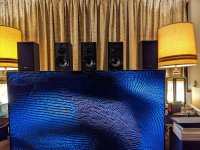




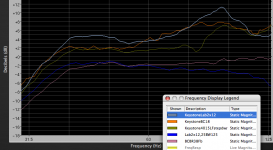
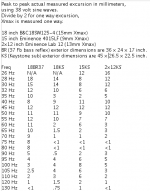
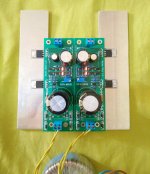
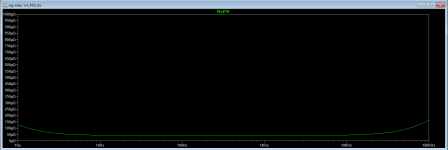

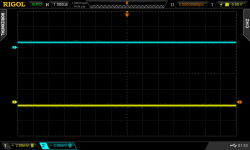
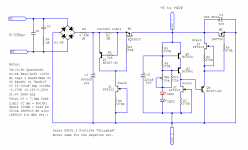
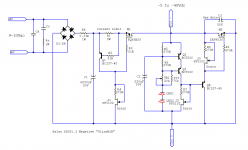
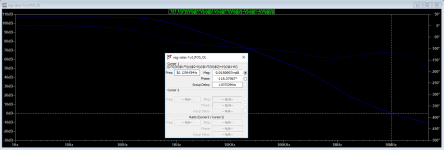
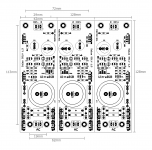





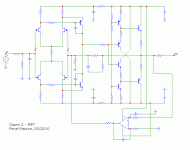
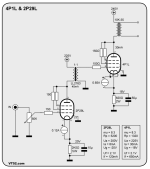


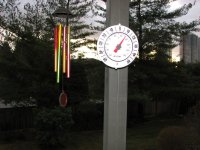


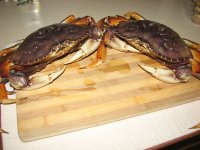
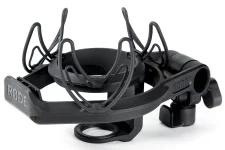

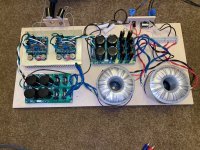
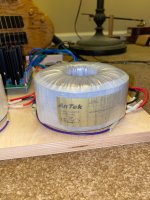
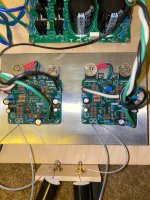


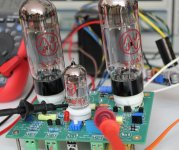
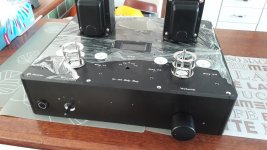
 And it's mine, which is priceless...
And it's mine, which is priceless...
